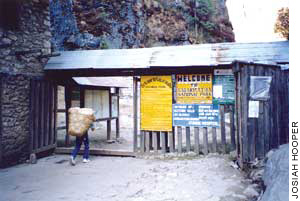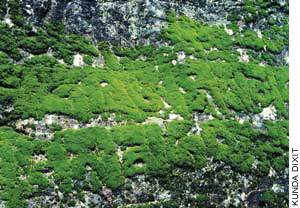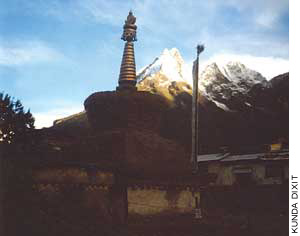 It was 1976, and we had just finished explaining the aims of the park to a gathering of local people, when shouts began to come from the crowd. "We don't need your park. Take your park to your own village." The meeting became unruly and meaningful consultation was out of question. We politely assured the crowd that their sentiments would be conveyed to the higher officials and left for the next village meeting.
It was 1976, and we had just finished explaining the aims of the park to a gathering of local people, when shouts began to come from the crowd. "We don't need your park. Take your park to your own village." The meeting became unruly and meaningful consultation was out of question. We politely assured the crowd that their sentiments would be conveyed to the higher officials and left for the next village meeting. There, we got more of the same. The Sherpa people were afraid that their use of the forests and pastures would be restricted. Even worse, they thought people to move out of their Khumbu villages. Local politicians were quick to take advantage of the fear. Some went around promising voters to put a fight against the park if elected. Despite the local opposition, the park was established.
In the early 1970s, interest in the exotic east peaked in western countries and Nepal became an important destination for mountaineers, adventure tourists, dharma bums and culture vultures. The number of tourist and mountaineers visiting Khumbu Region were growing rapidly. The local people were quick to adapt, getting into the business of providing food, lodging, and guiding and portering services. The economic benefits were immediate and obvious. Only the "experts" fretted about the risks to the environment and culture of the sacred Khumbu valley. Bigger trees were cut for construction of hotels and guesthouses. Huge amounts of firewood for sold and consumed at campsites for cooking and campfires. Garbage piled up along trails and near campsites. The traditional forest protection systems of the local people were being weakened under the new economic pressure.
 Eventually, the threats from unregulated tourism became a matter of concern internationally, and in Bonn in 1973, then Crown Prince Gyanendra committed to the international community that the Khumbu Region would be declared a national park to conserve its environment. The New Zealand Government co-funded establishment of the park at the recommendation of Sir Edmund Hillary.
Eventually, the threats from unregulated tourism became a matter of concern internationally, and in Bonn in 1973, then Crown Prince Gyanendra committed to the international community that the Khumbu Region would be declared a national park to conserve its environment. The New Zealand Government co-funded establishment of the park at the recommendation of Sir Edmund Hillary. The park administration adapted its regulations to accommodate the needs of the local residents. No people were displaced, and the local ways of life were permitted to continue undisrupted. Despite initial hostility, the park and people co-existed. Over time the forests, wildlife and landscape began to recover. Residents realised that people visited Khumbu to experience local culture and nature, and this reinforced cultural pride and the desire to preserve the environment. Tourist numbers grew and with them, so did the local economy.
Now, for the most part, attitudes towards the park are nearly uniformly positive. There is even talk of a formal silver jubilee celebrations. It is important, though, to go beyond the festivities and use this as a chance to reflect on the last 25 years and consider the future of the park.
Slow-growing trees
 The most important contribution of the Park was probably in conserving the high elevation forests and wildlife of Khumbu from uncontrolled exploitation. Trees, like humans, find it hard to thrive at high altitude. The Sagarmatha National Park is a vertical reserve: going from 3,000 m to 8,848 m. Trees take inordinately long to grow, it takes a lot more to safeguard them than it does forests at lower altitude. At about the time the park was formed, the traditional Sherpa ways of managing natural resources were dying out. The demand for forest resources were growing, incidences of illegal hunting and land encroachment were increasing.
The most important contribution of the Park was probably in conserving the high elevation forests and wildlife of Khumbu from uncontrolled exploitation. Trees, like humans, find it hard to thrive at high altitude. The Sagarmatha National Park is a vertical reserve: going from 3,000 m to 8,848 m. Trees take inordinately long to grow, it takes a lot more to safeguard them than it does forests at lower altitude. At about the time the park was formed, the traditional Sherpa ways of managing natural resources were dying out. The demand for forest resources were growing, incidences of illegal hunting and land encroachment were increasing. The park ensured that hunting was banned, use of firewood at trekking camps were discouraged, and that the rate of timber harvesting was brought down, to allow the forests to recover, regenerate and expand. Today the forest conditions of Khumbu have certainly not declined, even if we can't tell whether they've improved. The park's chain of forest nurseries and plantations supported by the Himalayan Trust is one of the most successful high-elevation forest regeneration programs in Nepal, and it has covered many hectares of bare slopes and filled open forests. The populations of wildlife commonly targeted by hunters in the past, such as the Himalayan tahr, musk deer, serow and pheasants have also recovered.
 The park has started to clean up litter, encourage alternative energy use, provide information to tourists and locals, and collected revenue for national coffers.
The park has started to clean up litter, encourage alternative energy use, provide information to tourists and locals, and collected revenue for national coffers. We'd never have guessed it back in 1976, but most of these changes are due to the participation and support of the people of Khumbu. There was a massive increase in tourism-arrivals in Khumbu jumped from about 3,000 in 1973 to nearly 26,000 in 2000. There are an additional 4,000 people living inside the park. Management of biodiversity, fuel, fodder, timber, and water for people, and aesthetics for visitors is a major challenge.
Now, the park needs to move beyond protection, and start managing forests, rangeland, wildlife, and tourism with participation of the local communities. It also needs to improve local livelihoods through community development programs. Infrastructure such as trails, bridges, and camps need to be better maintained with the revenue that visitors contribute. The construction of lodges and hotels, and the movement of non-local businesses into the park will need to be carefully managed. Most importantly, the park needs to be vigilant against major developments that are likely to have permanent impact on the integrity of it's values.





